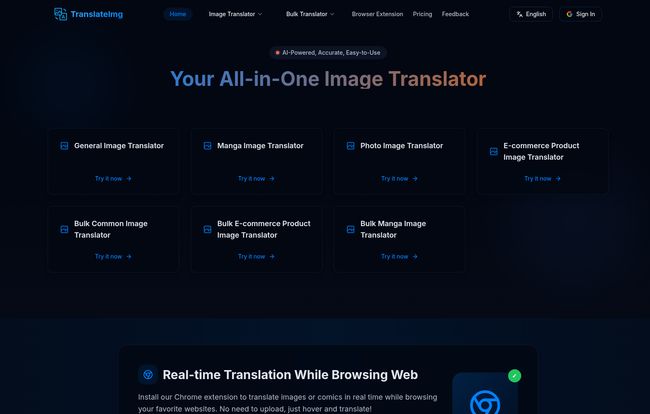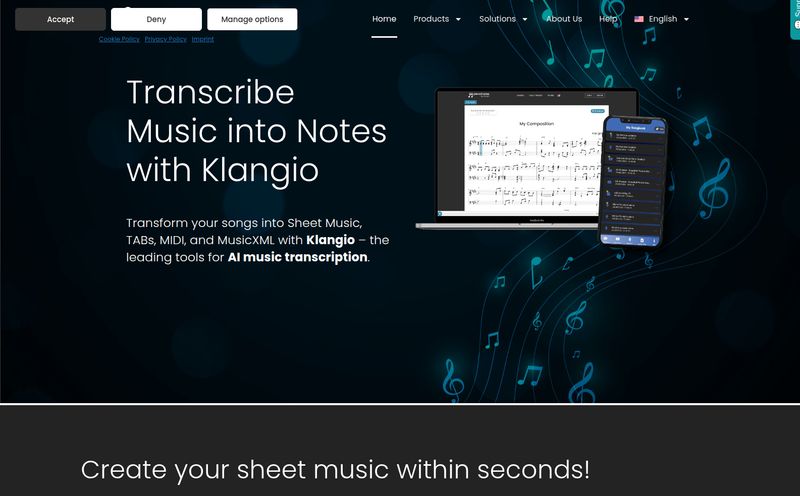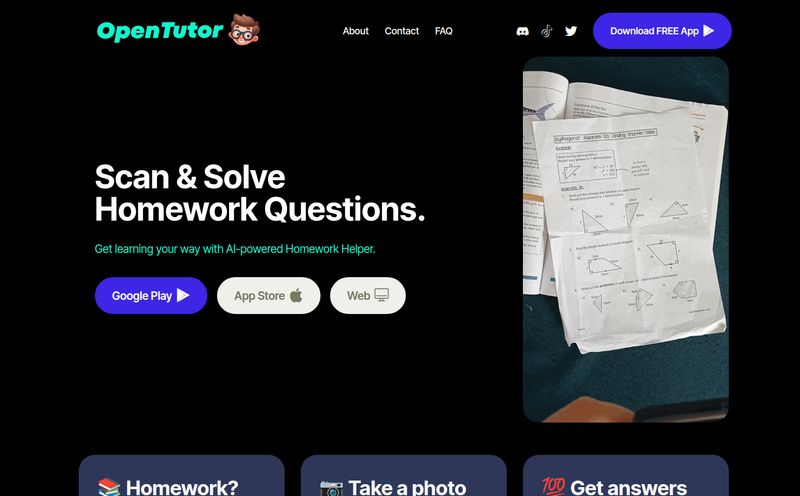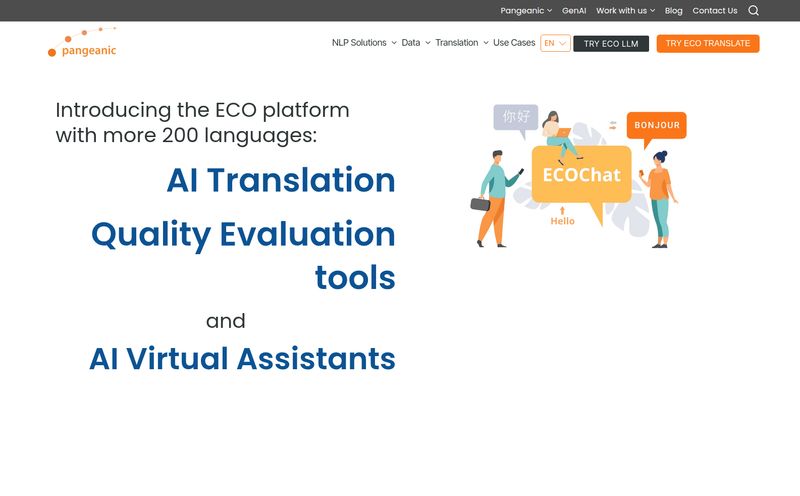If you’ve been in the digital marketing or SEO game for more than five minutes, you know the struggle. You're doing competitor research, and you stumble upon a killer ad from a German company. It's an image. You're scrolling through a Japanese e-commerce site for inspiration, and all the product callouts are in, well, Japanese. Or maybe you're just a normal person who loves manga and is tired of waiting for fan translations. The internet is a visual place, but language is still a massive barrier.
For years, the solution has been clunky. You screenshot the image, upload it to one tool to extract the text (if you're lucky), then copy-paste that text into another tool to translate it. The result? A jumbled mess of words, completely stripped of its original context, layout, and style. It’s like getting a transcript of a movie instead of actually watching it. You get the gist, but you miss the entire experience.
So, when a tool like TranslateImg pops up on my radar, claiming to instantly translate text within an image while preserving the layout, my professional curiosity gets the better of me. Is this another overhyped AI toy, or is it a genuinely useful tool that could change how we interact with visual content online? I had to find out.
So, What is TranslateImg, Really?
Let's get the elevator pitch out of the way. TranslateImg is an AI-powered platform designed to translate text from images, photos, and even manga into over 100 different languages. The big hook, the thing that makes it different from the old-school methods, is its promise to keep the original look and feel. The AI doesn’t just rip the text out; it carefully replaces it, trying to match the font, color, and position. Think of it less like a translator and more like a digital typesetter who happens to be fluent in a hundred languages.
It’s available as a simple web tool—you know, the classic drag-and-drop box—and as a Chrome extension for those of us who need translations on the fly while browsing. This dual approach is smart, catering to both one-off projects and daily workflow integration.
My First Impressions: Putting It to the Test
Talk is cheap, right? I decided to take it for a spin with a classic use case: a page from a manga. This is notoriously difficult. You’ve got different fonts, text in weirdly shaped bubbles, and sound effects splashed across the page. It's a true test of an AI's contextual awareness.
I grabbed a Japanese manga panel and dropped it into their web interface. And honestly? I was pretty impressed. It wasn’t instantaneous, it took a few seconds to process, but what came back was… coherent. The translation was solid, but more importantly, it was in the right place. The dialogue was in the speech bubbles, neatly formatted. It felt natural.

Visit TranslateImg
The translated text wasn't just slapped on top; it looked like it belonged there. This is a far cry from the disjointed text blocks I’m used to getting from other services. It’s the difference between a functional tool and a genuinely magical experience.
The Features That Actually Matter
A long list of features can be overwhelming. Most of the time, we only end up using one or two. With TranslateImg, a few features really stood out to me as being practical and well-executed.
The Magic of Context-Aware Translation and Layout Preservation
This is the secret sauce. The platform’s ability to not just translate, but to understand the context and preserve the layout is its main selling point. For a digital marketer, this is huge. You can now understand the messaging on a competitor’s social media graphic or website banner without losing the design cues. For an e-commerce store owner, you can quickly translate product images for different markets. It’s a powerful tool for anyone who works with international audiences. It’s not just translating the words; it's translating the entire visual message.
The Ever-Handy Chrome Extension
I'm a sucker for a good browser extension that saves me a few clicks. The TranslateImg extension brings the tool’s power directly into your browsing experience. Hover over an image with foreign text, and with a click, you can get a real-time translation. It lowers the friction to almost zero. Yes, you have to install it, which some people might see as a hassle, but for the convenience it offers, it's a no-brainer for anyone who regularly needs this functionality.
Bulk Translation for the Power Users
Now this is where things get interesting for businesses. Got a whole catalog of product images? A scanned document with hundreds of pages? A full manga volume? The bulk translation feature is designed for these heavy-lifting tasks. You can upload multiple files and let the AI do its work in the background. This is a massive time-saver and turns what would be a tedious, manual project into a simple, automated process. This is the kind of efficiency that directly impacts traffic generation and market expansion efforts.
Okay, What's the Catch? A Realistic Look
No tool is perfect, and it’s my job to be a little skeptical. While I was generally impressed, there are a few things to keep in mind. First, like any tool that relies on Optical Character Recognition (OCR), the accuracy depends heavily on the quality of the source image. A blurry, low-resolution JPEG with a super-fancy, unreadable font is going to give any AI a headache. Garbage in, garbage out, as they say.
Also, the free tier will likely have some limitations. This is standard practice—they give you a taste to show you how good it is, hoping you'll see the value in a paid plan. For casual, one-off translations it's probably fine. But if you're going to rely on this for business or a serious hobby, you'll probably need to pony up some cash.
Let's Talk Money: The Pricing Breakdown
So, what does this magic cost? The pricing structure is refreshingly straightforward, broken down into weekly, monthly, and annual plans. I appreciate when companies don't make you solve a riddle to figure out what you're paying for.
| Plan | Price | What You Get |
|---|---|---|
| Weekly | $4.90 | 600 translations/week. Great for a single, small project. |
| Monthly | $9.90 | 2000 translations/month, advanced AI, priority support, and batch translation. |
| Annual | $94.80 | Same as monthly but with 25% savings (works out to ~$7.90/month), premium quality, and API access. |
My take? The pricing is very reasonable. The weekly plan is perfect if you have one specific task and don't want to commit. The monthly plan is the sweet spot for serious hobbyists (hello, manga readers) and small businesses. The annual plan is clearly aimed at agencies, e-commerce stores, or developers who need API access and the best possible price. The 25% saving is a pretty good incentive to go for the yearly commitment if you know you'll use it.
My Final Verdict: Is TranslateImg Worth Your Time and Money?
After playing around with TranslateImg, I can say it's one of the most impressive single-purpose AI tools I’ve seen this year. It takes a common, frustrating problem and solves it with an elegance that other solutions lack. The focus on preserving the original layout isn’t just a gimmick; its the core feature that makes it so useful.
It’s not going to be for everyone. If you just need a quick text translation, Google Translate is still your friend. But for anyone who works with visual media across different languages—marketers, designers, researchers, e-commerce pros, and yes, manga and comic fans—this tool is a legitimate game-changer. It bridges the language gap in a way that feels intuitive and, dare I say, a little bit magical.
For a small monthly fee, it removes a significant bottleneck in many workflows. In my book, that's a tool worth paying for.
Frequently Asked Questions
- How accurate is the translation on TranslateImg?
- It's very good, powered by context-aware AI. However, accuracy can depend on the image quality. Clear text on a clean background will yield better results than blurry text on a complex background. It's always a good idea to have a human review critical translations.
- Can it really keep the original formatting and style?
- For the most part, yes! This is its standout feature. The AI does an excellent job of replacing the text within the original layout, matching the position and trying to approximate the font style. It's one of the best I've seen at this.
- Is there a free version of TranslateImg?
- The site implies a free usage tier, which likely comes with limitations on the number of translations or features. It's designed to let you test the service before committing to a paid plan for more extensive use.
- What's the main difference between the Monthly and Annual plans?
- Both plans offer 2000 translations per month and batch processing. The Annual plan, however, gives you a 25% discount on the overall price, offers premium translation quality, and includes API access for developers, which the monthly plan does not.
- Do I need to install anything to use TranslateImg?
- No, you can use the main tool directly on their website by uploading an image. They also offer an optional Chrome extension for translating images directly while you browse the web.



